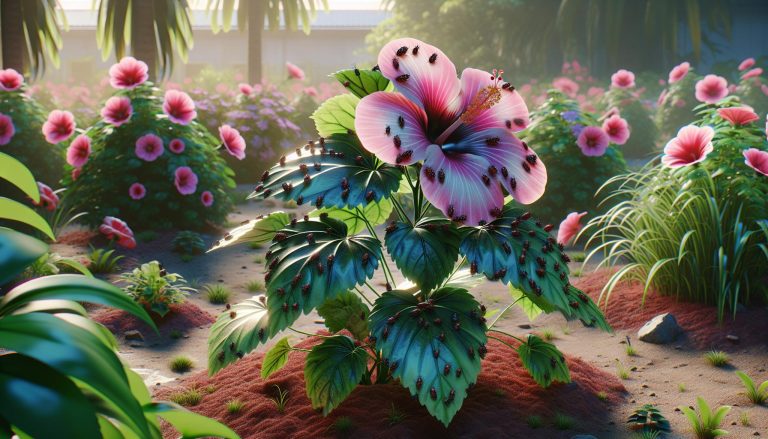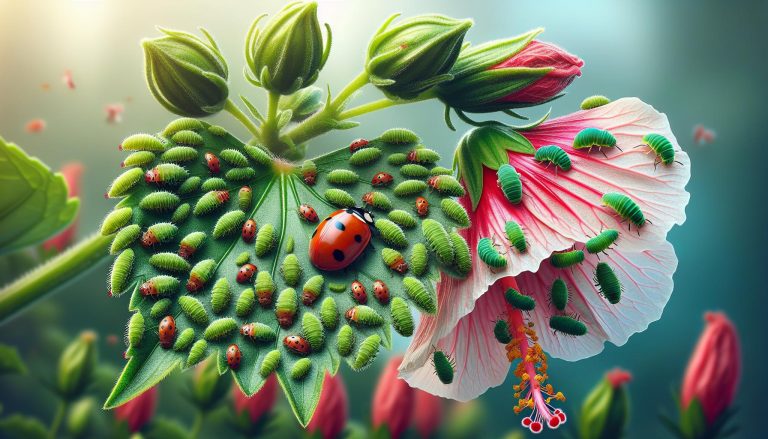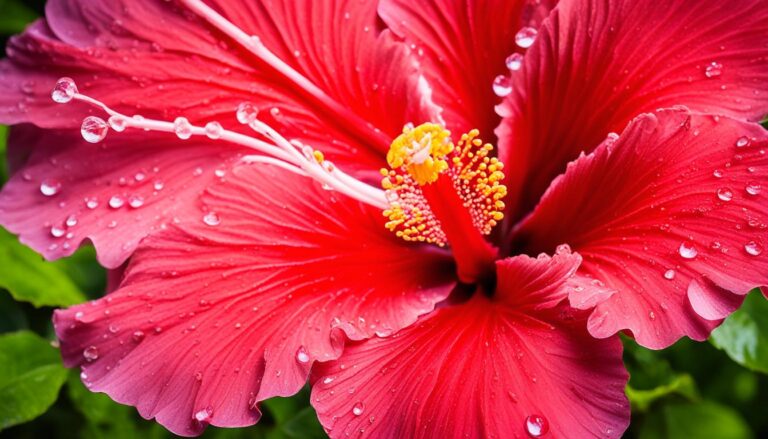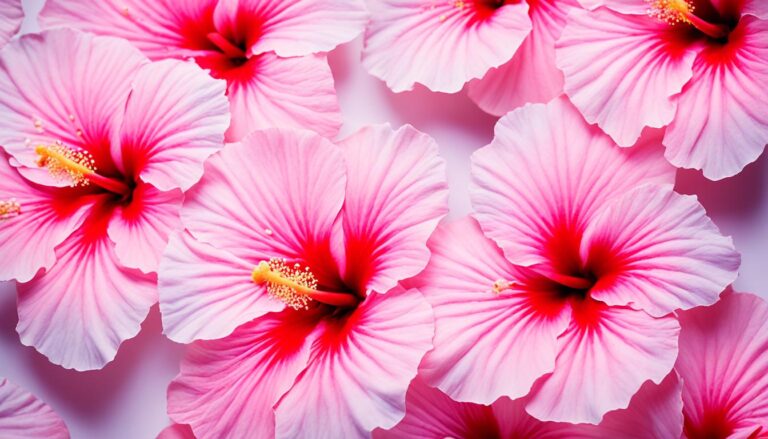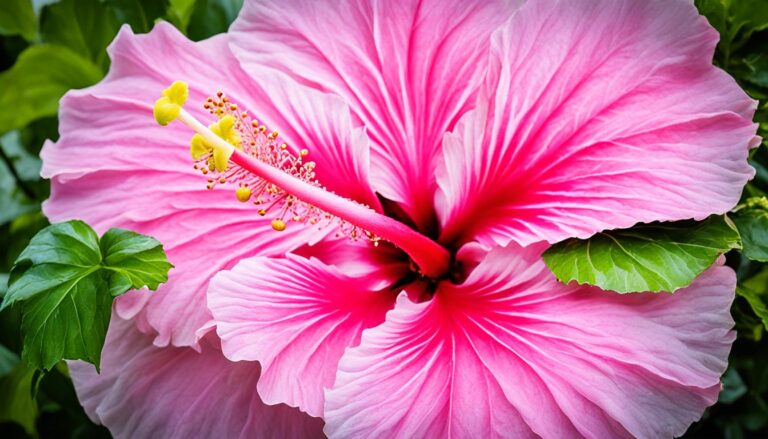Hibiscus Showdown: Tree vs Bush – Care & Propagation Guide
Navigating the vibrant world of hibiscus, we often find ourselves marveling at their beauty and diversity. But when it comes down to choosing between a hibiscus tree and a bush, things can get a bit confusing. Both forms share the same dazzling flowers and can transform any garden into a tropical paradise, yet they have their unique needs and characteristics.
Hibiscus trees and bushes are susceptible to similar challenges, such as yellowing, curling, and drooping leaves, often due to sunlight and watering issues or even pests and diseases. Despite these hurdles, they continue to grow rapidly under the right conditions, adding a significant splash of color to our gardens. With the tree variant reaching heights of more than ten feet and the bush spreading wide, each offers a distinct appeal.
Whether you’re drawn to the towering elegance of the hibiscus tree or the lush, expansive spread of the bush, understanding their differences is key to making the right choice for your garden. Let’s dive into the hibiscus world, exploring the nuances that set these two apart and how they can both bring beauty and life to our outdoor spaces.
Key Takeaways
- Hibiscus trees and bushes differ primarily in growth habits and physical characteristics, with trees having a single main trunk and reaching over ten feet in height, while bushes spread widely with multiple stems, creating a dense foliage.
- Both hardy and tropical hibiscus varieties have unique needs: Hardy Hibiscus is suitable for colder climates (zones 4-8) and can survive winters with proper care, whereas Tropical Hibiscus thrives in warmer zones (9-11) and requires
Understanding Hibiscus: Tree Vs Bush
Key Differences and Characteristics
When distinguishing between hibiscus trees and bushes, the primary differences lie in their growth habits and physical characteristics. A hibiscus tree typically exhibits a single main trunk, branching out to form a canopy much like any other tree. This growth pattern allows it to achieve heights of more than ten feet, making it an imposing yet beautiful addition to any garden.
On the other hand, a hibiscus bush presents a more compact and bushy appearance, with multiple stems growing from the base. These bushes spread wide, often as much as they grow tall, creating a lush, dense mass of foliage and flowers. While bushes may not reach the towering heights of their tree counterparts, they compensate with their breadth, filling garden spaces with vibrant color and texture.
Flower size and leaf shape can vary between the two, but both share the hallmark hibiscus qualities: large, colorful blossoms, and glossy leaves. The choice between a hibiscus tree and bush, therefore, often comes down to gardeners’ spatial preferences and aesthetic goals.
Habitat and Growth Patterns
Understanding the natural habitats and growth patterns of hibiscus trees and bushes can also guide gardeners in their selection. Hibiscus trees thrive in full sun, requiring at least six hours of direct sunlight daily to flourish. They prefer well-draining soil and are somewhat tolerant of drought once established, making them suitable for a variety of garden settings.
In contrast, hibiscus bushes, while also enjoying full sun, can often tolerate slightly more diverse conditions. They are adaptive to different types of soil, as long as it’s well-draining, and can handle partial shade environments without significant detriment to flowering. This versatility makes the bush variety a perfect candidate for gardeners working with less than ideal sunlight conditions or those looking to fill underused shady spots with color.
Both the tree and bush forms of hibiscus are fast growers under favorable conditions, adding about 24 inches to their stature annually. Gardeners should consider this rapid growth when planning their garden spaces, ensuring adequate room for each plant to reach its full potential. Whether opting for the majestic height of a hibiscus tree or the expansive coverage of a bush, understanding these fundamental differences and growth patterns will help achieve a garden that’s both beautiful and thriving.
Choosing the Right Hibiscus Plant for Your Garden

After understanding the fundamental differences between hibiscus trees and bushes in terms of their growth habits and physical characteristics, it’s crucial to delve deeper into the types of hibiscus plants available. This knowledge will assist you in selecting the ideal plant for your garden, ensuring it thrives and brings you joy with its vibrant blossoms. Let’s explore the characteristics of Hardy and Tropical Hibiscus, along with the nuances between tree and bush variants, to help you make an informed decision.
Hardy Hibiscus
Our first contender in the hibiscus selection process is the Hardy Hibiscus, a resilient variety that can withstand colder climates. Hardy Hibiscus plants are known for their ability to survive winter temperatures as low as 30°F (-1°C), making them suitable for gardens in zones 4 through 8. These plants die back to the ground in winter and return with vigor in the spring. If you live in an area with harsh winters and still wish to enjoy the beauty of hibiscus, the Hardy Hibiscus, including varieties like the rose of Sharon, may be the perfect choice for your garden. Remember, these plants appreciate a little extra care in the form of winter protection, such as being wrapped in fabric to ward off the chill.
Tropical Hibiscus
In contrast, Tropical Hibiscus is a dream for those residing in warmer climates, specifically zones 9 through 11. This variety thrives in temperatures between 55 and 70 degrees but will require protection if the temperature dips below 50 degrees. The Tropical Hibiscus is known for its perennial nature in warm climates, capable of growing year-round with the correct conditions. They prefer full sun and well-draining soil, aligning with the needs of their tree counterparts. For gardeners in cooler zones, fear not; Tropical Hibiscus can still grace your garden as ornamental annuals, bringing a slice of the tropics to your space during the warmer months.
Hibiscus Plant Types: Tree and Bush Variants
With a clearer understanding of the Hardy and Tropical Hibiscus, we now shift our focus to choosing between tree and bush forms. Hibiscus trees, characterized by their single trunk, can grow over ten feet tall and are ideal for gardeners looking to add a vertical element to their space. On the other hand, hibiscus bushes, with their multiple stems, spread wide and create a dense, colorful display of foliage and flowers. Both types boast large, vivid blooms and glossy leaves, with the choice ultimately depending on your garden’s spatial layout and your aesthetic preferences. Whether you’re leaning towards the statuesque presence of a hibiscus tree or the lush, sprawling beauty of a bush, ensure you provide the plant with adequate sun, well-draining soil, and the space to flourish.
By weighing the characteristics of Hardy and Tropical Hibiscus alongside the merits of tree and bush variants, you’ll be well-equipped to select the hibiscus plant that best suits your garden’s climate, space, and aesthetic goals. Knowing your garden’s zone, the space available, and your climate’s typical temperature range will guide you in making a choice that ensures your hibiscus not only survives but thrives.
Planting Hibiscus: Tree and Bush Care

Optimal Growing Zones
For hibiscus trees and bushes to flourish, identifying the optimal growing zone is crucial. Hardy Hibiscus varieties thrive best in USDA zones 4 through 9, showcasing their resilience to colder temperatures. They invite gardeners in these regions to enjoy their vibrant beauty without the worry of winter’s harshness. On the other hand, Tropical Hibiscus prefers the warmth of USDA zones 9 through 11. Their love for milder winters and reluctance to tolerate frost distinguishes their preference for sunnier states. By situating these plants in their ideal zones, we ensure they not only survive but thrive, gracing gardens with their lush foliage and stunning blooms.
Soil and Light Requirements
Soil and light play pivotal roles in the health and beauty of hibiscus trees and bushes. A well-draining soil rich in organic matter forms the cornerstone of their growth. For Tropical Hibiscus, a slightly acidic to neutral pH is preferred, whereas Hardy Hibiscus is more forgiving, adaptable to a broader range of soil conditions. Proper light conditions are equally significant. While Hardy Hibiscus prospers in full sun, relishing six or more hours of direct sunlight daily, Tropical Hibiscus appreciates a mix of full sun and partial shade, especially in areas with intense afternoon heat. This balance encourages a prolific bloom and supports robust growth, ensuring these ornamental beauties achieve their full potential.
Planting in Ground Vs. Pot
Deciding whether to plant hibiscus in the ground or in a pot depends on several factors, including climate, space, and personal preference. Planting directly in the ground is suitable for gardeners in optimal growing zones for their chosen hibiscus type. It offers these plants more room to expand, anchoring them for vigorous growth and abundant flowering. However, for those in cooler zones or with limited garden space, growing hibiscus in pots is a versatile option. Potted hibiscus can be moved indoors to escape winter’s chill or rearranged as needed for aesthetic or sunlight requirements. Containers should provide ample space for roots to grow and ensure proper drainage to prevent waterlog from damaging the plant. Whether nestled in garden soil or thriving in a pot, with the right care, hibiscus trees and bushes can be a spectacular addition to any gardening space.
Maintenance and Care for Hibiscus Plants

Watering Needs
Maintaining the right moisture level is crucial for hibiscus plants, whether they are of the tree or bush variety. Hibiscus plants are fond of water, which plays a significant role in their overall health. For freshly planted hibiscus, keeping the soil constantly moist for the first two weeks supports initial growth. As general guidance, when the top inch of soil feels dry, it’s time to water the plant. This might mean watering four to five times a week during hot, sunny weeks, and less frequently during cloudier or cooler periods. Adjusting watering frequency with the seasons is essential, as hibiscus plants require less water during winter. Overwatering can lead to root rot, so ensuring the soil is moist but not saturated is key.
Fertilization Guidelines
To ensure your hibiscus plants thrive, incorporating the right fertilizer into your care regimen is necessary. Opt for a hibiscus-specific fertilizer, such as HibisGain 12-6-8, to provide essential nutrients. Hibiscus prefers well-drained soils with a pH of 5.5 to 6.5. If the soil is alkaline, a hibiscus-specific fertilizer can help offset potential micro-nutrient deficiencies. Apply a slow-release fertilizer during the early spring to encourage growth and flower production. Remember, while fertilization is important for promoting flowering, it’s equally crucial not to over-fertilize, as this can harm the plant.
Pruning Techniques
Pruning is not only about maintaining the aesthetic appeal of your hibiscus plants but also about promoting healthy growth and abundant flowering. For both hibiscus trees and bushes, pruning helps in shaping the plant, controlling its size, and removing dead or diseased branches. The best time to prune is early spring, before new growth begins. For hibiscus bushes, thin out crowded branches to increase air circulation. Hibiscus trees may require trimming to maintain their shape and encourage branching. Always use clean, sharp pruning tools to make clean cuts, which help prevent disease and encourage quicker healing. Pruning also stimulates new growth, leading to more flowers and a robust plant.
Common Challenges in Growing Hibiscus
Growing hibiscus, whether as trees or bushes, brings vibrant colors and tropical vibes to gardens. However, like any plant, hibiscus faces several common challenges that can affect their health and blooming ability. Let’s delve into these challenges, particularly focusing on pests and diseases, as well as environmental stressors.
Pests and Diseases
One of the foremost challenges we encounter in growing hibiscus is the outbreak of pests and diseases. Hibiscus trees are particularly vulnerable to pests like aphids, spider mites, and whiteflies, which suck the sap from the leaves and stems, causing damage and sometimes disease. These pests not only weaken the plant by taking its nutrients but can also lead to sooty mold due to the honeydew they excrete.
Diseases, especially fungal ones like root rot, are serious threats too. Root rot, primarily caused by overwatering and poor drainage, prevents the plant from absorbing nutrients and water, leading to the plant’s rapid decline. Similarly, canker diseases can affect the hibiscus, leading to reduced plant vigor and, in severe cases, the death of the plant. Early detection and removal of affected parts are crucial in managing these diseases. Ensuring good air circulation around the plants also helps in preventing the spread.
Environmental Stress and Its Effects
Hibiscus plants can also suffer from environmental stress, which, if not managed, leads to yellowing, curling, and drooping of leaves. These signs often indicate that the plant is either getting too much or too little sunlight. Likewise, incorrect watering practices—either too much or too little—can significantly stress the plant, impacting its health and flower production.
Temperature plays a significant role in the health of hibiscus plants. While they thrive in warmer climates, sudden frost can damage or even kill tropical hibiscus varieties. It’s important to protect these plants from cold by covering them with frost cloth or bringing them indoors if potted. Similarly, hardy hibiscus varieties, while more tolerant of colder temperatures, still require protection from extreme weather conditions to ensure their survival and bloom in the following season.
In addressing these challenges, proper care and maintenance become vital. Regularly inspecting the plants for pests, providing adequate water, and ensuring the soil has good drainage and nutrient levels will help minimize stress and promote healthy growth. Moreover, adapting planting and care strategies to accommodate the environmental conditions of your area ensures that your hibiscus, whether a tree or bush, flourishes throughout the season.
Propagating Hibiscus: Trees and Bushes
When and How to Propagate
Propagating hibiscus, whether trees or bushes, involves a few simple steps that, if followed correctly, can result in healthy, vibrant new plants. Propagation usually takes place in the early spring, before the hibiscus starts its active growth phase and before flower buds appear. This timing ensures that the plants put their energy into establishing strong root systems rather than flowering.
For both trees and bushes, taking cuttings is the most common method of propagation. Here’s a step-by-step guide to propagating hibiscus through cuttings:
- Select Healthy Stems: Choose healthy, disease-free stems that are about 6 inches long. Make sure these stems do not have a flower or a flower bud to increase the chances of successful rooting.
- Prepare the Cuttings: Remove the lower set of leaves from the stem, leaving one layer of leaves at the top. This reduction of leaves lowers the stress on the cutting to maintain moisture while still allowing enough leaf area for photosynthesis.
- Root the Cuttings: Place the prepared stems in water or a moist potting mix. If using water, change it every few days to keep it fresh. For those opting for a potting mix, cover the container with plastic to create a humid environment conducive to root growth.
- Wait for Roots to Appear: Roots typically begin to form within a few weeks. Once the cuttings have developed a good root system, they can be transplanted into their own pots or directly into the garden.
Besides cuttings, hibiscus can also be propagated from seeds or by division, though these methods are less commonly used. Propagating by division is generally exclusive to bush varieties and involves physically splitting the plant’s root system into several smaller sections, each of which is then replanted.
Regardless of the method chosen, proper timing and care during the early stages of propagation are crucial. Before taking cuttings or dividing plants, ensure your tools are clean and sharp to prevent damaging the parent plant and spreading disease. And remember, patience is key. It takes time for new hibiscus plants to establish themselves and bloom, but the reward of vibrant flowers and lush foliage is well worth the effort.
Hibiscus Through the Seasons

After exploring the distinctions between hibiscus trees and bushes, their growth habits, and outlining the steps for propagation, it’s crucial to understand how seasonal changes impact these vibrant plants. We’re diving deeper into how to navigate the care of hibiscus through the seasons, ensuring these tropical beauties thrive year-round.
Winter Care Tips
Caring for hibiscus in winter requires special attention, especially for tropical varieties that aren’t accustomed to the cold. First, we bring potted hibiscus indoors once temperatures consistently dip below 50°F. A bright, sunny spot mimics their natural environment, promoting health during these cooler months. For those planted in the ground in areas where winter is mild, providing a thick layer of mulch acts as a cozy blanket, insulating the roots against chillier nights.
Watering demands lessen as the plant’s growth slows; hence, we reduce the frequency ensuring the soil doesn’t become waterlogged. Though it’s a rest period for the hibiscus, vigilant pest checks remain essential. Indoor heating can foster a dry environment, so we often recommend misting the leaves or employing a humidifier to maintain humidity levels conducive to hibiscus health.
Seasonal Planting and Blooming Cycles
The rhythm of planting and the blooming cycle of a hibiscus are intricately tied to the seasons. For most varieties, early spring, after the last frost has passed, presents the ideal time for planting. This timing allows the hibiscus to establish its roots well before the heat of summer encourages prolific blooming.
From late spring until fall, hibiscus flowers make their dramatic appearance, rewarding our careful preparations with stunning, continuous blooms. The length of the blooming season is a testament to the loving care we’ve provided, with fertilization in early spring and again midway through the growing season, ensuring a standout floral display.
Transitioning plants indoors during winter or ensuring protection outdoors lays the foundation for the next year’s growth cycle, allowing these tropical and subtropical wonders to thrive under our watchful eye, season after season.
Conclusion
We’ve explored the vibrant world of hibiscus, from the structural elegance of trees to the lush density of bushes. Understanding their unique needs ensures they thrive, whether it’s battling pests or mastering propagation. Remember, the key to vibrant blooms lies in timing and care, from selecting the right moment to plant to providing winter protection. Let’s embrace these challenges as opportunities to grow alongside our hibiscus, enjoying their stunning flowers for seasons to come.
Frequently Asked Questions
Do hibiscus trees bloom all summer?
Hibiscus trees, particularly the Hardy Hibiscus varieties, bloom from mid-to-late summer. Their flowering period starts in June and can extend into the fall, showcasing a variety of colors.
Where is the best place to plant a hibiscus tree?
The ideal location for a hibiscus tree is in full sun, although they can tolerate partial shade. In regions with intense summer heat, some afternoon shade may be beneficial. Plant them in or at the back of perennial flower beds for best growth and flowering.
Do hibiscus trees come back every year?
Yes, perennial varieties of hibiscus like the Hardy Hibiscus return each year. They typically emerge later than many perennials, so patience is required. Apply extended-release fertilizer in late spring to support new growth.
Do hibiscus trees spread?
Hibiscus trees naturally spread to maximize sunlight exposure on their leaves. The extent of their spread varies among species, with some growing more upright than others.
How long do hibiscus trees live?
Garden-variety hibiscus trees can live up to 50 years, reaching heights of 15 feet or more. However, newer hybrid varieties may have shorter lifespans of around 5-10 years and grow at a slower rate.


